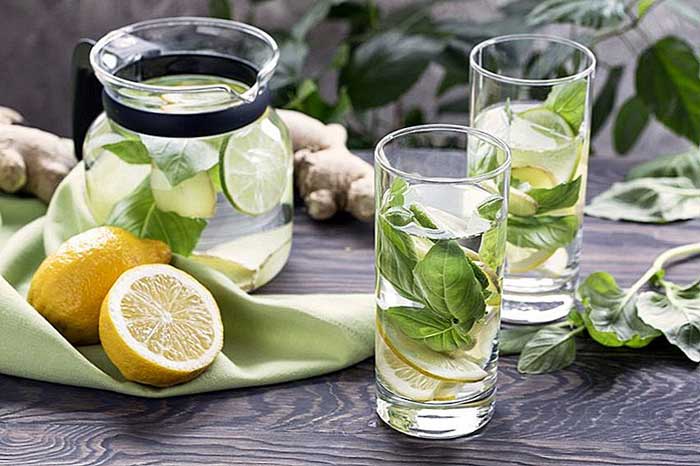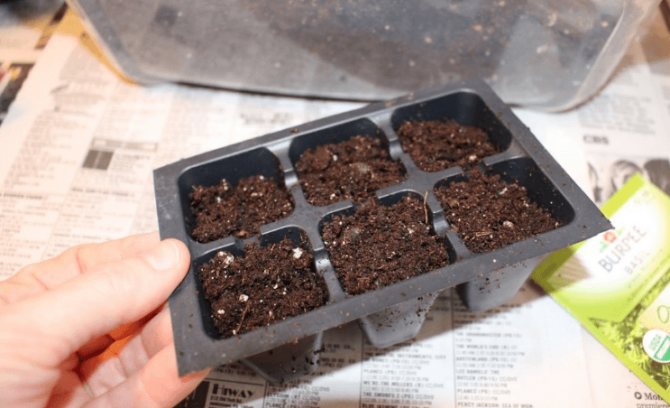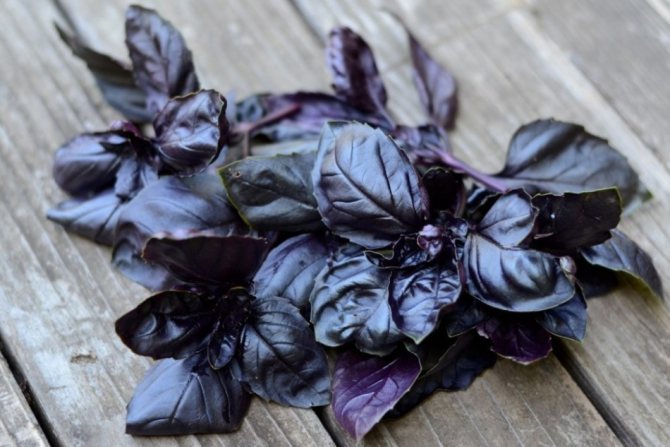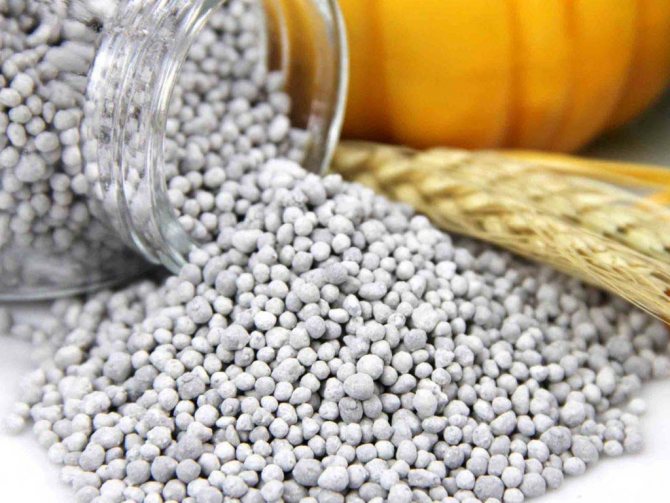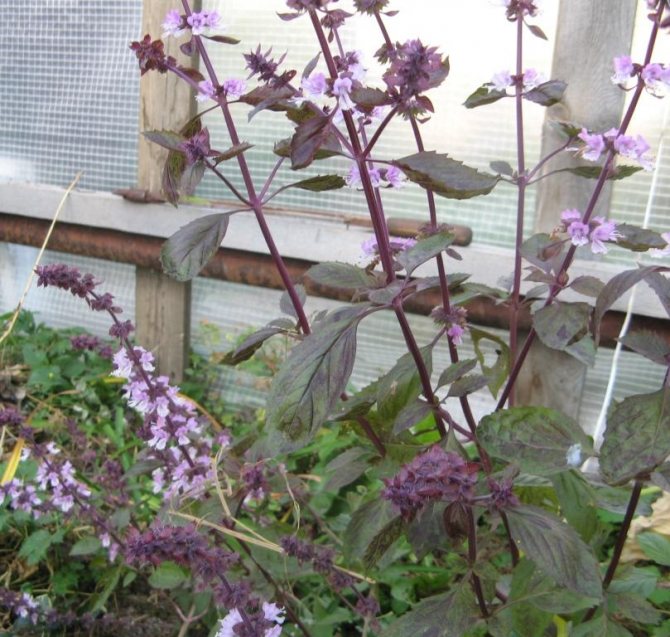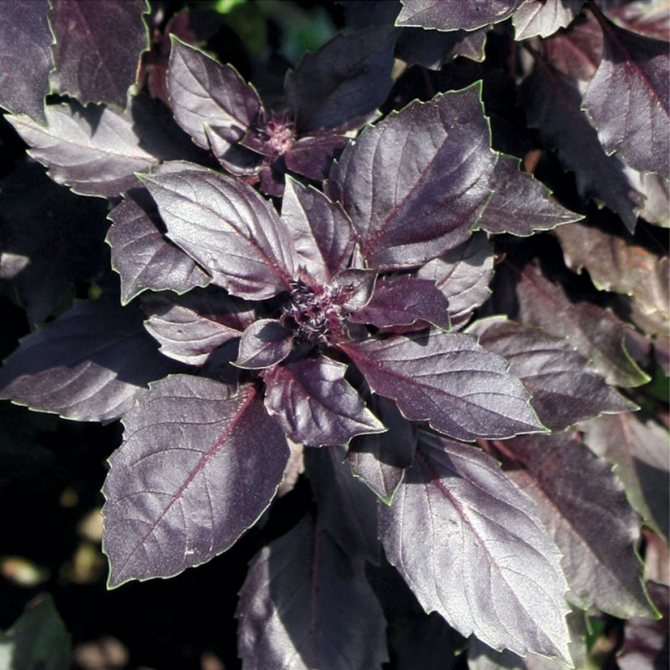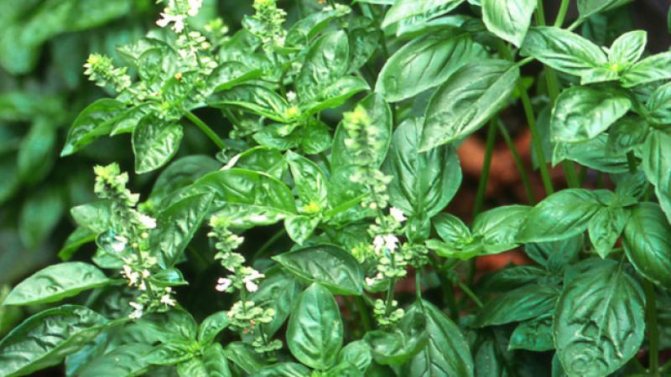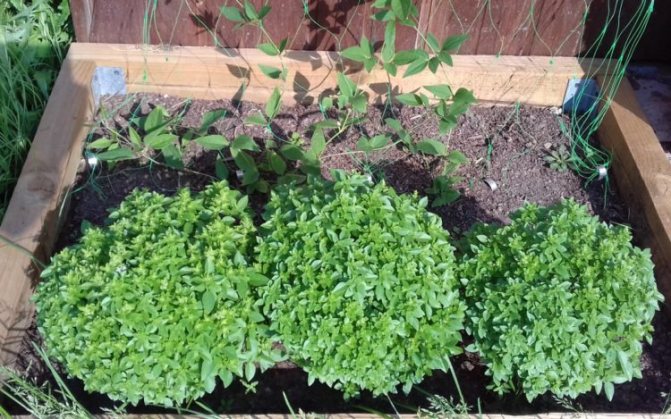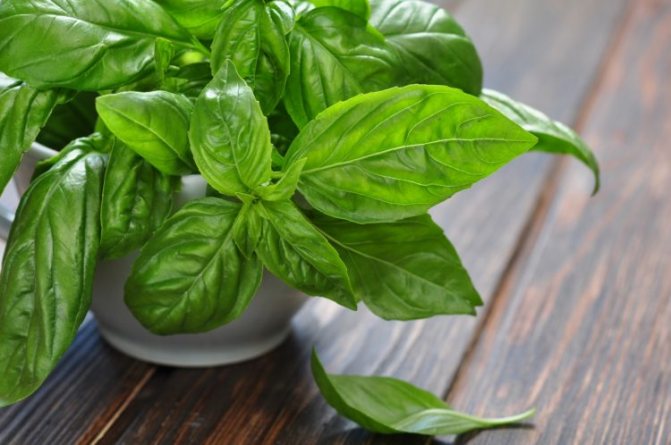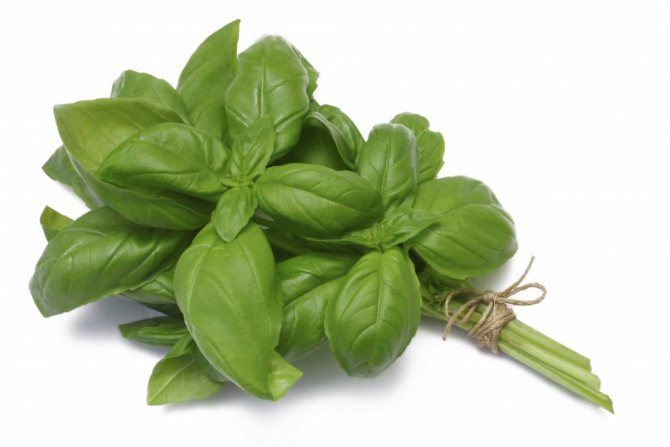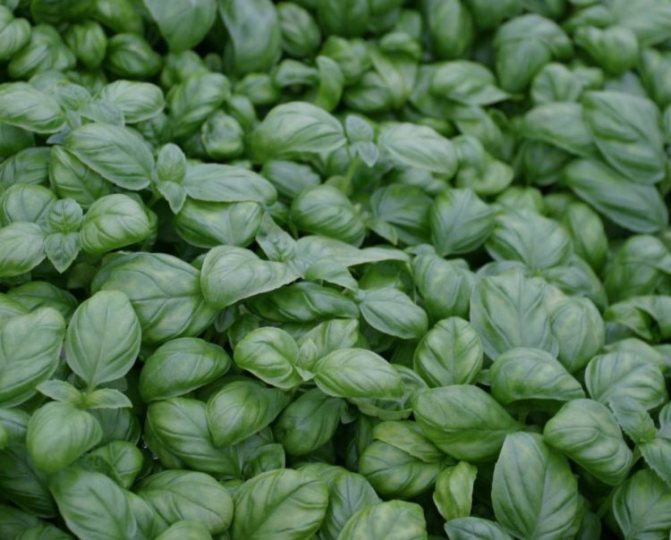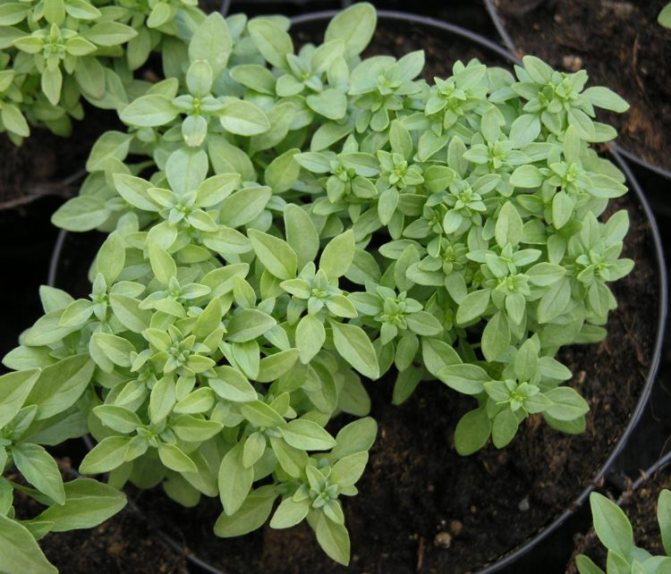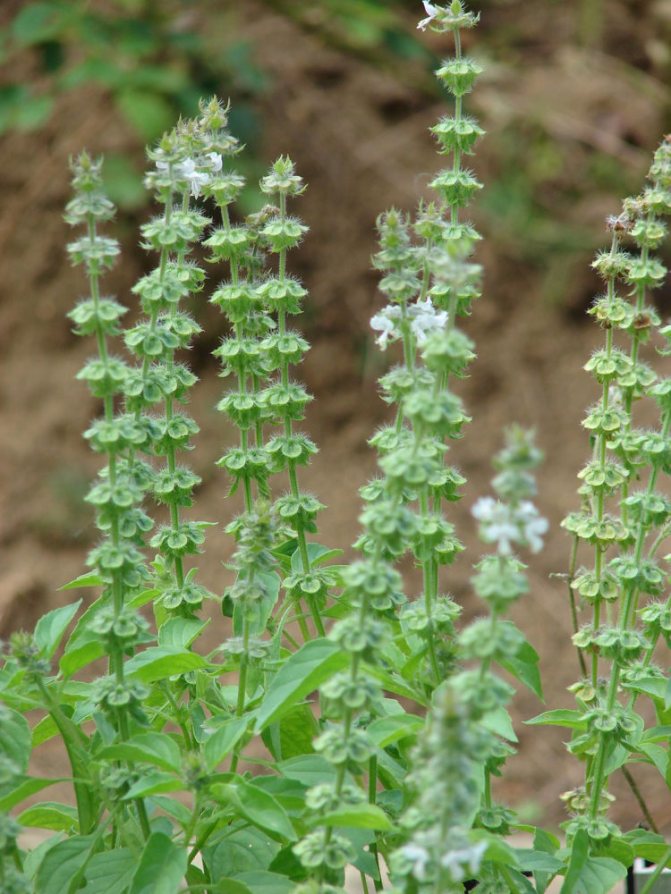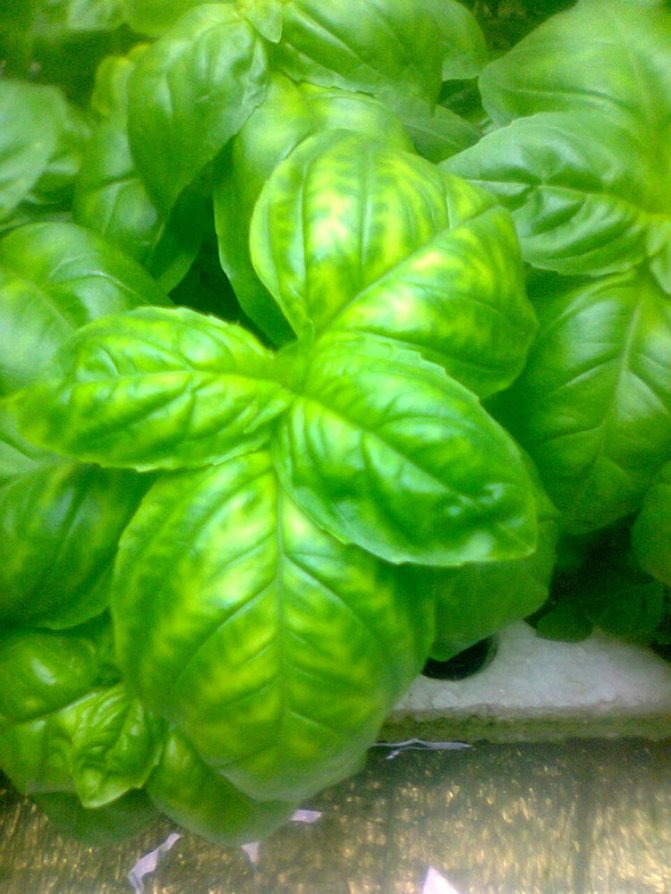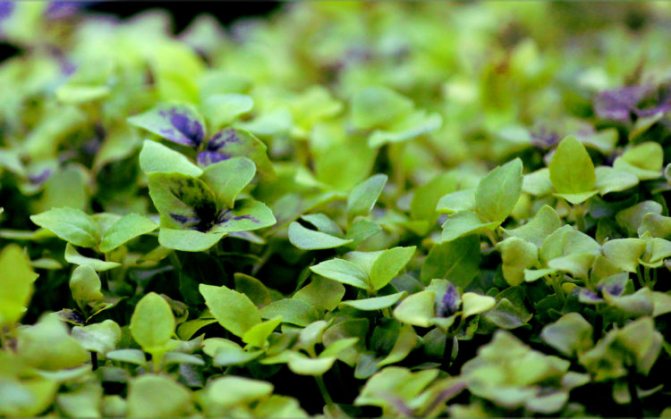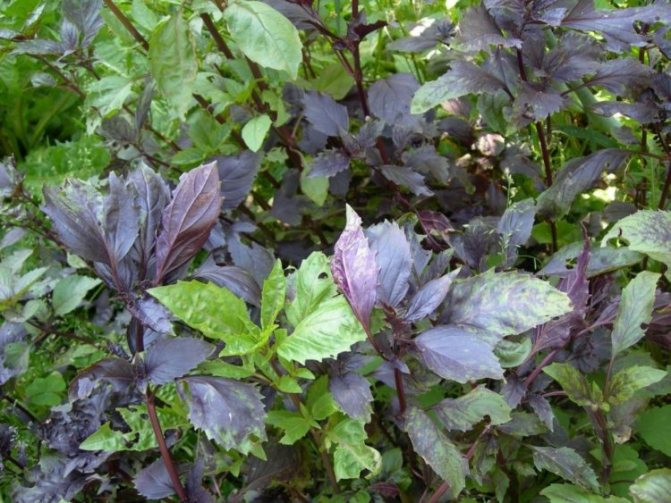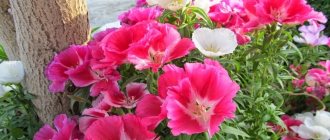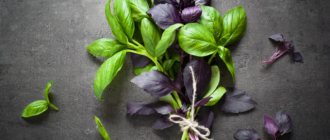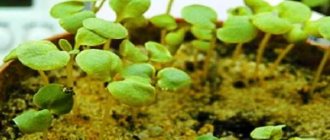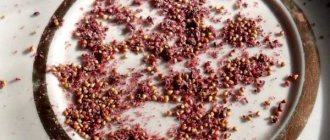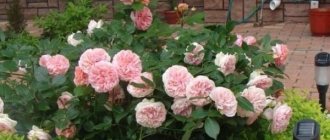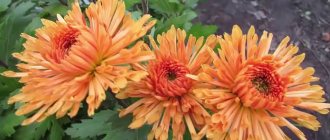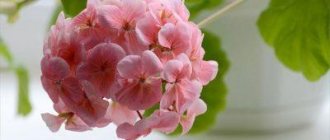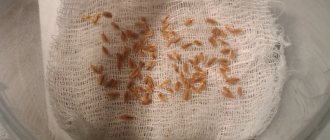
There is no brighter spicy herb in the summer cottage than basil, the photo of the varieties of which amaze with juicy green, purple and violet tones. The aroma of fresh herbs is no less rich. Depending on the variety, the fragrance of the leaves resembles the smell of pepper and vanilla, cinnamon, camphor, lemon and clove, caramel and all kinds of combinations of these notes.
There are several dozen types of basil in the world, but only a few are used for breeding and cultivation as a garden and essential oil crop. Read: basil - health benefits and harms for men!
Ancient history of purple and red basil
Basil became known to mankind over 5000 years ago. All this time it was actively used for culinary and medical purposes. Basil tea has a calming effect on the nervous system and tones the body. The drink helps to improve the functioning of the liver and gallbladder.
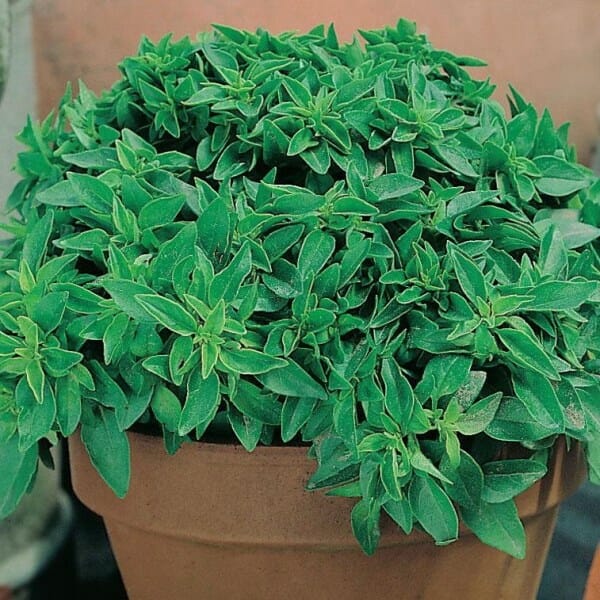

Basil in a pot close up
Africa is considered the birthplace of the basilica. In Russia, they learned about the miraculous properties of this herb in the 18th century. In those days, cosmetics were prepared from it in the form of tonics and masks. Basil is also used today to improve the condition of the skin.
Preparing the soil for seedlings
From early to mid-April, you can sow seeds in shallow (5-7 cm) boxes for seedlings. For planting, use either a purchased ready-made mixture, or one prepared independently from peat, humus and sand, respectively, in a ratio of 4: 2: 1. The sand must be sieved and steamed in a water bath for about an hour. Disinfect the soil with a strong solution of potassium permanganate or another antiseptic (for example, phytosporin). Before sowing, it is well moistened.


How to plant seeds or seedlings outdoors
Basil dies under the influence of low temperatures. In this regard, the seedlings are planted in the garden when the morning frost has passed. It is best to plant this plant in the spring, in mid-May. The sowing scheme can be any.
Basil responds well to fertile, moisture-permeable soil. Mandatory fertilization is required before planting. For 1 m2, 2 kg of humus, peat and compost are applied.
The distance between the shoots should be about 40 cm. The depth of the holes is 10 cm. Before planting, the holes must be watered.
Experienced summer residents do not recommend planting basil in the same place for two years in a row. If this moment is not taken into account, brown spots will appear on the leaves of the plant, and over time it will die. This disease is called fusarium. Its pathogens are fungi that live in the ground for a long time. The optimal planting interval should be 5 years.
Basil views, photos and short descriptions


Fragrant, noble or common basil with a peppery aroma and pungent taste has become the basis for breeding plants with smooth, large and often wrinkled leaves. Thanks to the work of breeders, the varieties obtained on the basis of this type of basil acquired the smell of lemon, menthol, vanilla.
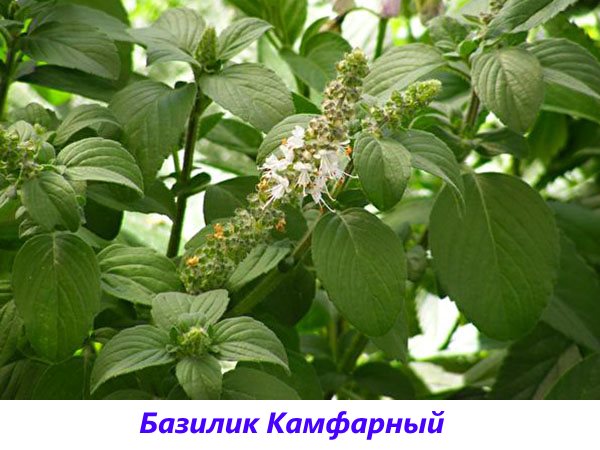

The leaves, inflorescences and stems of the camphor or mint-leaved variety, in contrast to the fragrant basil, are covered with small hairs, some of which contain a fragrant essential oil that determines the recognizable aroma.Thermophilic, like other types and varieties of basil, the plant has long been appreciated by pharmacists and perfumers. Before World War II, the herbaceous shrubs of the basil shown in the photo in the south of the country were grown for the industrial production of camphor.
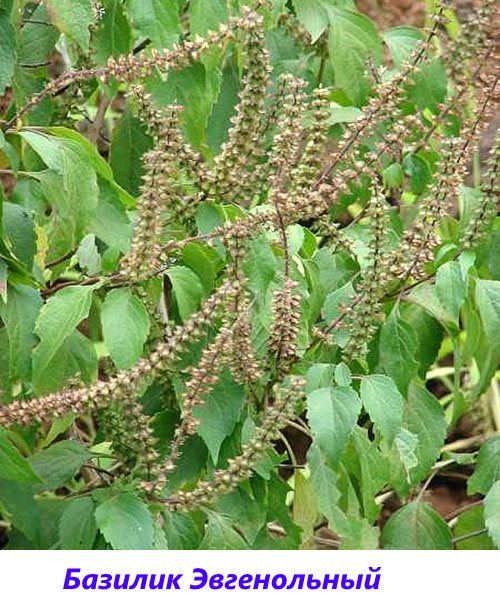

In the Crimea, in the Kuban and in the North Caucasus, eugenol basil is grown, which is almost twice as large as its counterparts and, due to the high content of eugenol, has a bright clove smell. The plant is highly regarded as an essential oil crop and serves as a raw material for the production of a vanillin substitute for perfumery and cosmetic products.
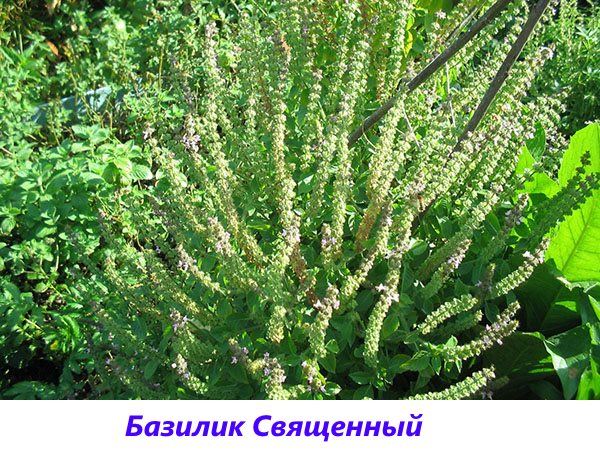

In India, of all the varieties and types of basil, we especially revered the sacred or fine-colored basil. In a warm climate, tulasi, as this plant is called, has the appearance of a perennial herbaceous shrub, has a sharp smell of cloves, and the leaves can be both green and purple.
The aroma of basil is determined by the combination of essential oils present in the greens.
Modern varieties have an incredibly bizarre range of smells, which is not available to any spice and flavor culture.
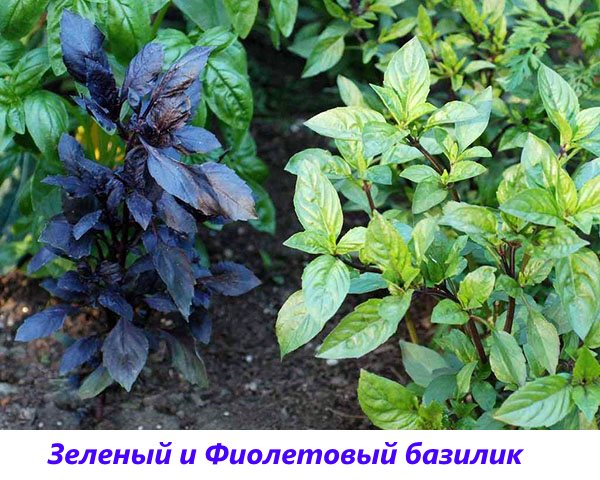

At the same time, all varieties of basil grown in gardens, as in the photo, are thermophilic and can seriously freeze even at zero temperature. But this does not stop summer residents who are planting seedlings or sowing basil already at the beginning of summer, when the time of frosts and cold nights has passed.
Growing and caring for green shoots of basil in the garden
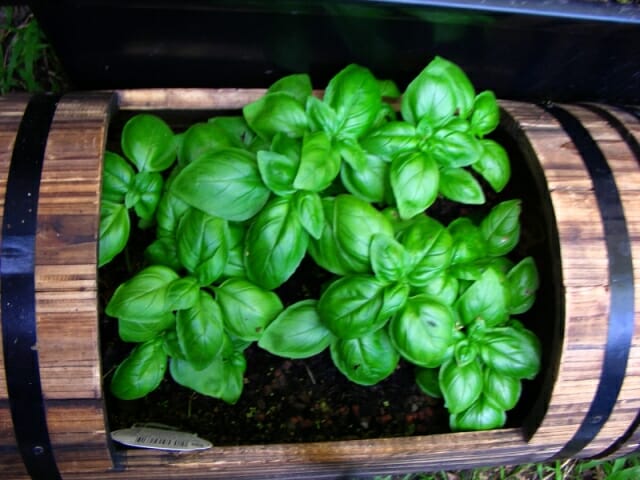

Keg Grown Basil
In order for basil leaves to delight with their spicy taste and healthy leaves, it needs to be properly cared for. The plant needs abundant watering with warm, settled water. It is best to fill a plastic barrel with it, put it in the sun and wait for it to warm up. In the evening, the water can be used for irrigation.
Tips & Tricks
Onions - growing and care in the open field
A good harvest of basil requires some effort. The plant requires good growing conditions, warmth, sun and regular watering. To exclude the development of diseases, you need to adhere to the following recommendations:
- always prepare the soil before planting seedlings;
- to obtain fragrant leaves, water the plant with nettle infusion;
- sufficient watering will provide a pleasant basil flavor to the leaves;
- greens are cut if the length of the shoots is more than 12 cm;
- for harvesting for future use, the plant is cut off at the beginning of the flowering period.
Following the rules for planting basil, growing from seeds, and when planting outdoors will help to harvest a good harvest of leaves.
Collecting crops in the garden
The basil leaves must be harvested before they bloom. It was during this period that it contains an abundant accumulation of vitamins and essential oils. Unripe buds will tell you that the grass can be cut.
Basil blooms until autumn. The plant loves warmth, so it must be placed in a house or greenhouse before the first frost. It grows well in a pot for indoor plants. Basil will not only decorate the room, but also fill it with an incredible spicy aroma.
Descriptions and photos of varieties of basil of domestic selection
The industrial cultivation of basil in the USSR began in the 1920s. Then the culture was recommended only for the southern regions, including the Crimea and the Caucasus. The Voronezh region was then recognized as the northern border of the comfort zone. Today, excellent varieties of green and purple basil are available to gardeners in other areas.
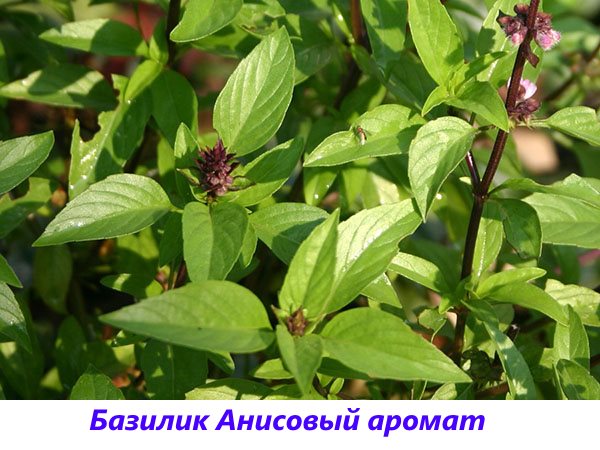

Basil variety Anise The aroma with a fresh, sweet-spicy smell of anise is easily recognizable not only by the aroma, but also by the combination of green, rather small leaves and reddish-brown or green-purple stems. A medium-sized bush willingly branches and supplies the summer resident with excellent spicy greens throughout the warm season.
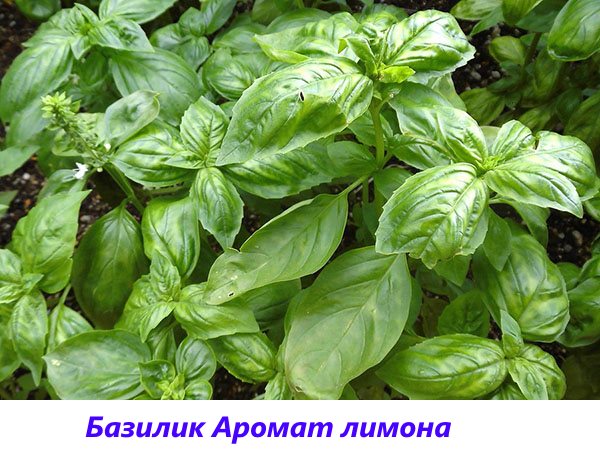

Basil variety, pictured, Lemon aroma for cooking gives juicy bright greens with an invigorating lemon scent in a month and a half after germination. The variety belongs to large-leaved varieties with a characteristic, bubbly shape of leaf plates, and also stands out for a high concentration of essential oils that give green foliage the ability to soothe coughs, soothe stomach cramps, and facilitate the treatment of inflammatory diseases and wounds.
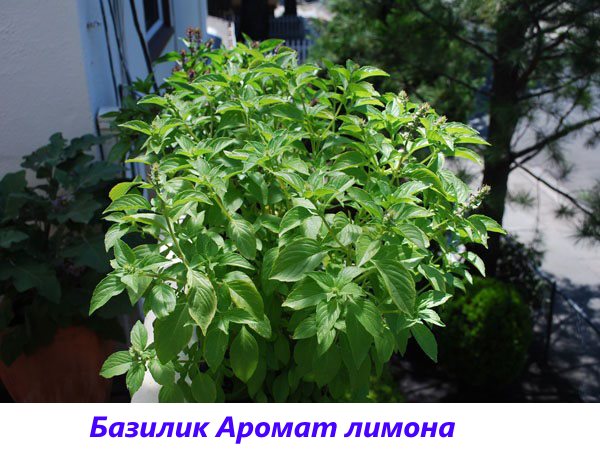

Bred specifically for lovers of spicy, spicy tea, the Lemon aroma forms a small, up to 35 cm high bush with light green leaves and white-green spike-shaped inflorescences.
The entire aerial part of this early-ripening lemon basil contains many essential oils and can be used both fresh and for winter harvesting, drying and freezing.


Basil Vanilla aroma does not stand out for its large size. The bush grows only up to 35 - 40 centimeters, but the variety with purple jagged leaves and lilac flowers is still very interesting to gardeners. The reason is the sweetish smell of vanilla, unusual for a spicy herb, which makes basil indispensable in desserts and fruit and berry preservation, in sweet pastries and fruit salads. The spicy leaf will add an oriental character to your tea.
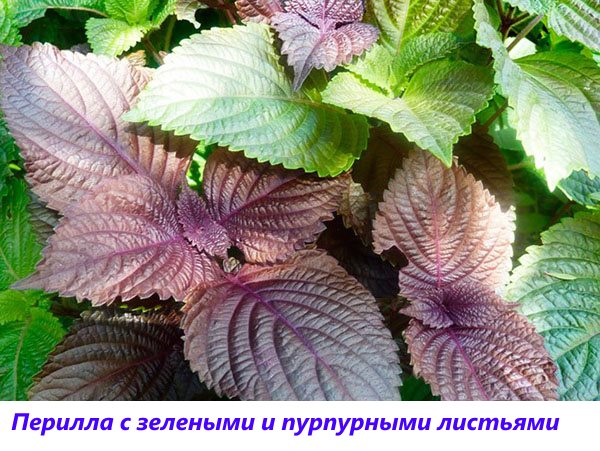

Varieties with this leaf tint are often referred to as purple or red basil. But in this case, do not confuse basil with perilla, a lesser-known spice with green, variegated or purple foliage of a pointed-heart-shaped or curly shape.
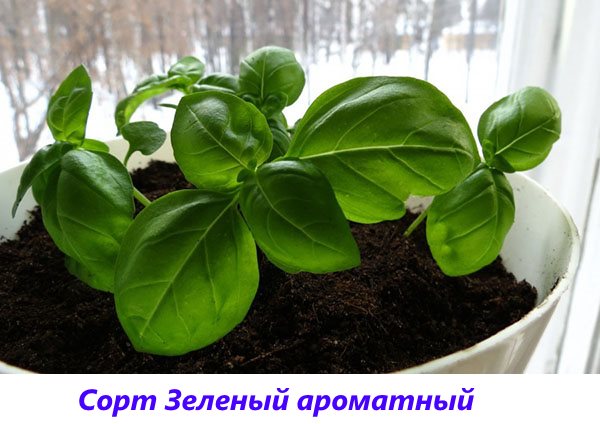

Basil Green fragrant after sowing grows quickly, forming a well-branching shrub with a height of 40 to 50 centimeters. Large foliage is colored bright green, has a smooth crunchy surface and a piquant spicy aroma. Basil variety, pictured, goes well with fresh tomatoes, cottage cheese and cheese, can be used in meat dishes and marinades.
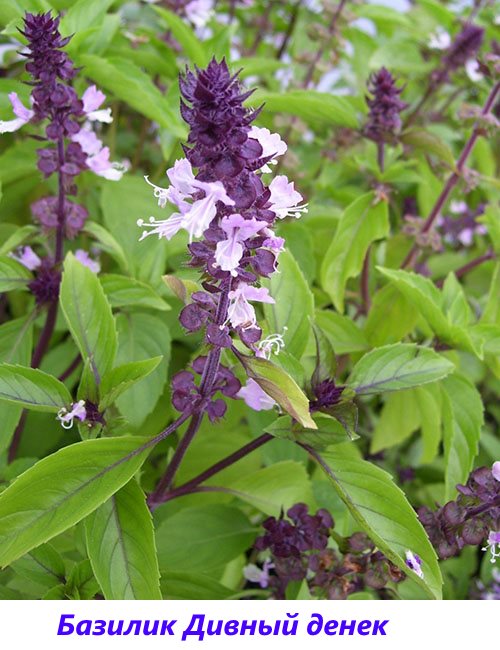

Basil variety Wonderful day will delight the gardener with a fresh aniseed scent and a spicy, pleasant taste. The leaves of this variety are small, with deep purple veins. The stems are anthocyanin-colored, branch well and reach a height of 40-50 cm.
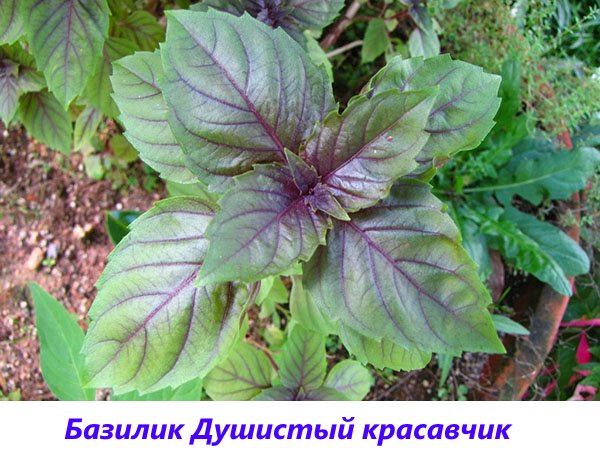

The cinnamon aroma of basil The fragrant beauty and its bright green-lilac leaves made the variety one of the leaders among summer residents of Russia. An unusual addition to fruits, desserts, hot and cold drinks will delight both adults and young gourmets.
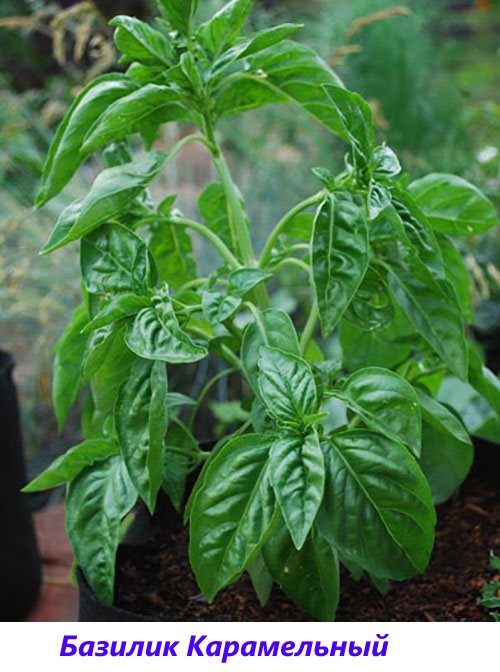

The Caramel variety belongs to the mid-season varieties. One and a half or two months after sowing, the plant forms a bush 40–50 cm high with smooth dark green foliage. The main feature of the culture is revealed in the name of the variety. The greens have a pleasant caramel flavor that will undoubtedly add a spicy note to desserts, baked goods, fruit salads and homemade products.
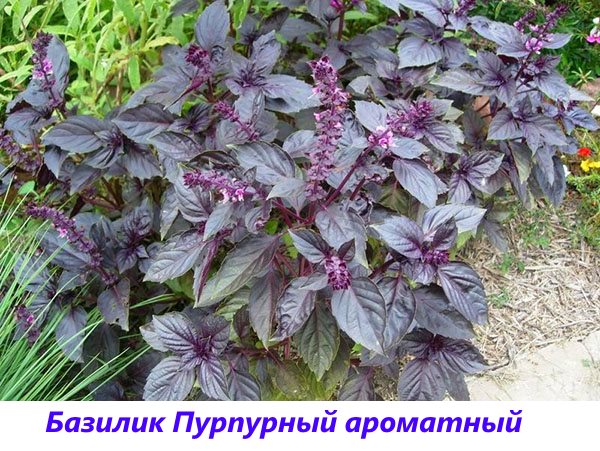

Basil Purple aromatic - an irreplaceable addition to roasted and baked meat, fresh salads and marinades. A basil bush with purple foliage, the same stems and pink-purple inflorescences per season gives up to 230 grams of excellent fragrant greenery and branches quickly when pinching the tops.
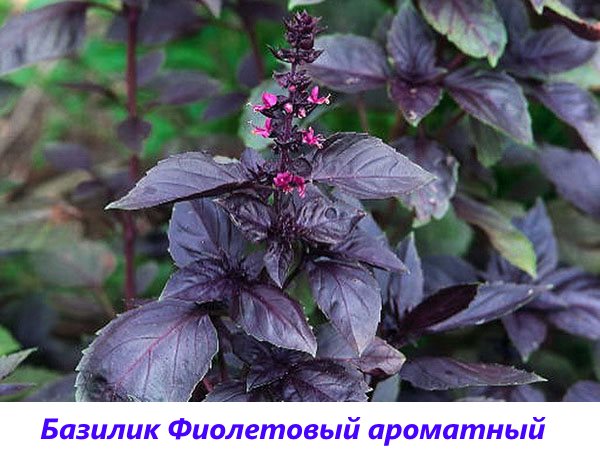

Basil Violet fragrant with large purple-red leaves and crimson or purple flowers has a rich pepper aroma. To preserve the smell, the leaves are recommended to be added fresh, and also used in marinades, home preservation, for the preparation of flavored vegetable oils and vinegar.
The variety belongs to the mid-early varieties, and over the summer from the plant you can get up to 250 grams of fresh foliage.
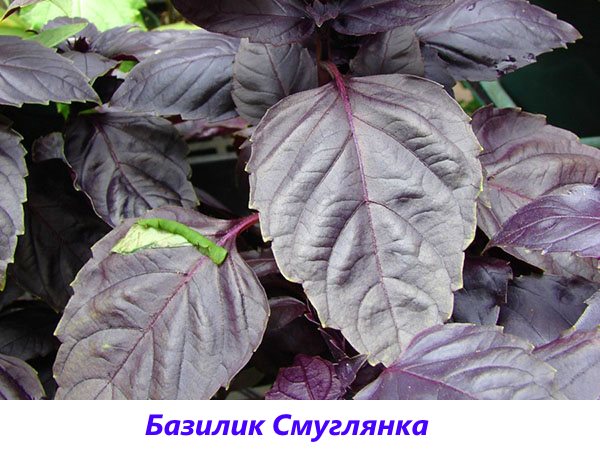

Basil variety Smuglyanka will delight lovers of spicy purple foliage with a bright peppery smell and tart taste, indispensable in pickles and salads with ripe tomatoes or spaghetti.


One of the most famous and favorite varieties of basil, in the photo, is rightfully considered Ararat with purple flowers, purple-violet stems and green leaves, generously decorated with lilac, purple dusting and veins. The greens of Ararat basil have a classic peppery aroma, pleasant taste, and the plants are entirely prized for their productivity, fast growth rates and great taste.


For lovers of plant growing on the windowsill, the Basilisk basil depicted in the photo with medium-sized green leaves and a bush only 20 centimeters high is suitable. At home, greens with a pepper-clove smell grow without problems throughout the year. Even an adult plant grown for garden beds can be transplanted into a pot.
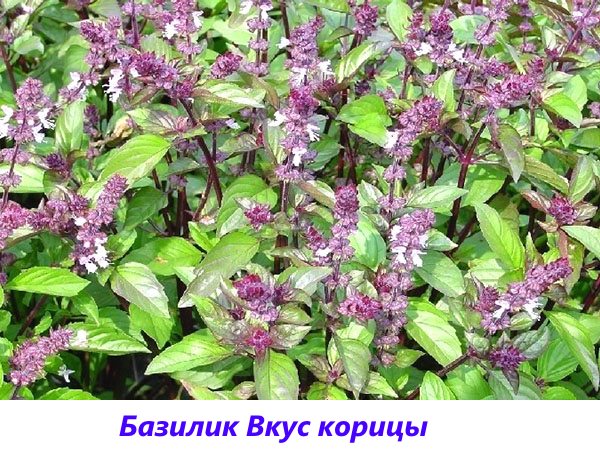

Early spicy herbs will give the summer resident basil Taste of Cinnamon. The leaves of this variety not only have an unusual cinnamon aroma for the culture, but also decorate any dish thanks to the purple or violet veins penetrating the entire leaf plate.
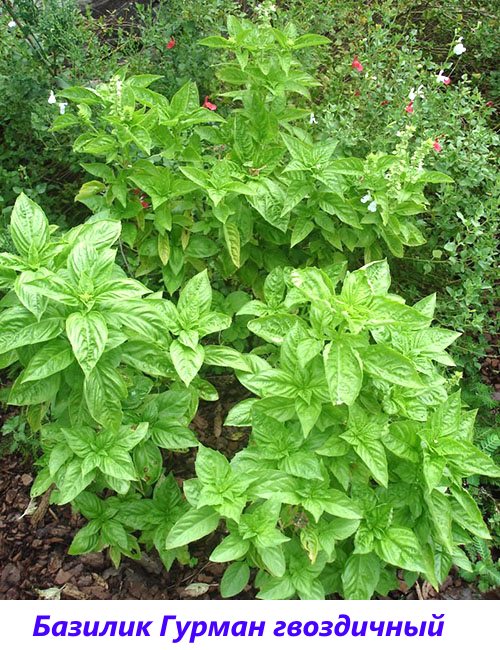

A mid-season variety of green basil Gourmet Clove is a truly versatile plant whose delicious foliage goes well with vegetables and meat, cheese and fish. The abundantly growing greens are suitable for fresh consumption and do not lose their clove smell after drying. During the season, a bush up to 60 cm high gives about 800 grams of juicy elliptical leaves.
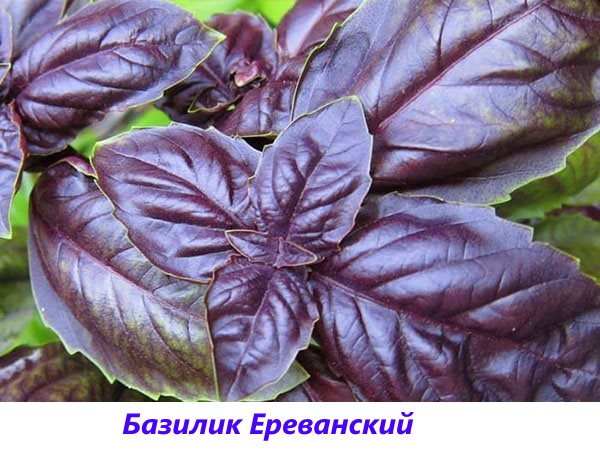

The purple basil of the Yerevan variety, well-known to Russian gardeners, quickly forms a sprawling, well-branching bush up to 60 centimeters high. The leaves of this variety have a pepper aroma with warm tea shades and do not lose their properties after drying or freezing.
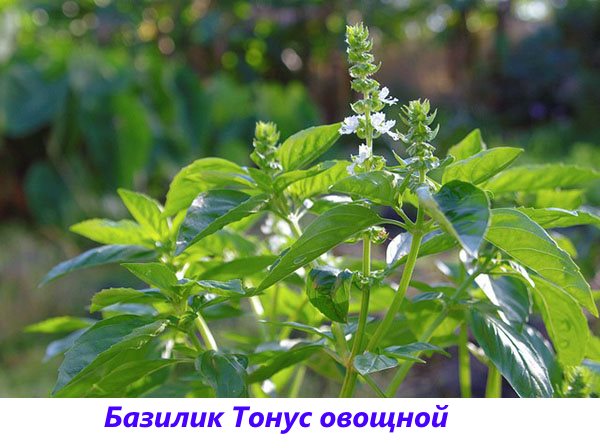

Vegetable tonus, which gives a spicy clove aroma and smack of home preservation, is one of the most popular varieties among summer residents, in demand due to its high yield and bright clove scent of greenery. During the season, rapidly growing shrubs from a square meter give up to three kilograms of spicy foliage for universal use.
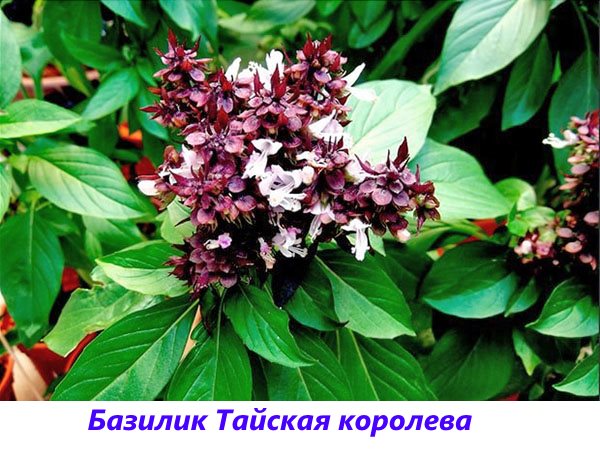

Even in the photo of the Thai Queen basil variety, you can clearly see how original and bright this plant looks. The variety, which has rightfully received the royal title, not only amazes with its unusual purple-lilac inflorescences and elongated green foliage. The greens of this variety have a classic peppery smell and a spicy taste. This kind of basil, which blooms for two months, will be appreciated by lovers of ornamental plants, as well as those who keep pots of herbs at home, on a windowsill or balcony.
Correct drying
When the crop is harvested, it must be dried. This can be done in different ways:
- On open air. The leaves are washed, debris removed, laid out on a towel. After the water has drained, they are placed on a baking sheet. If the leaves are large, it is better to collect them in bunches, tie and hang them to dry on a rope in a warm room.
- In the oven. Clean and dried leaves are laid out on a baking sheet and sent to the oven, preheated to 400 ° C for 2 hours.
- In the microwave. To dry the grass, turn on the device at full power and leave the plant in it for 3 minutes.
You can manually determine the readiness of the basil. If it's completely dry, the greens will crumble in your hands. Glass jars or paper bags are suitable for storing spices.
Growing basil from seeds
Basil seeds can be purchased at specialized stores. This is the most suitable option when planning the cultivation of several bushes of a plant. If basil grew in your summer cottage in the summer, which suited you in all respects, then it is quite possible to collect its seeds yourself. It should be borne in mind that only those plants that you planted through seedlings will give full and high-quality seeds: with direct planting in the ground in a temperate climatic zone, the seeds of this spice do not have time to ripen. Seeds are harvested in dry weather when the bracts dry up and darken:
- The dried peduncle is cut from the plant and placed in a darkened, well-ventilated room for ripening.
- After drying, the seeds spill out of the boxes themselves. They must be cleaned of debris and additionally dried.
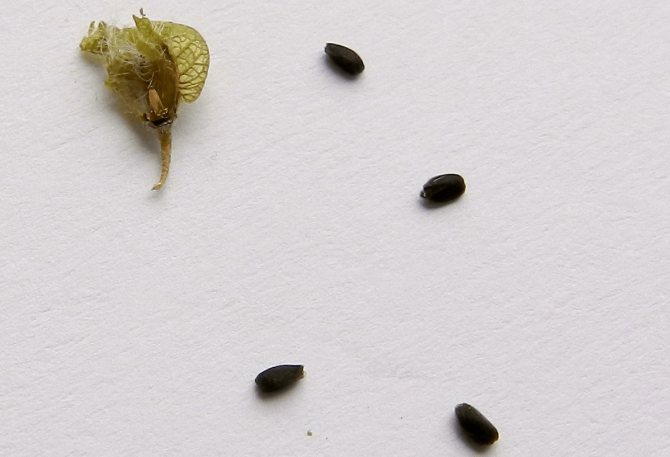

Ripe basil seeds should be black
Basil seeds germinate for 4–5 years.
Preparation of planting material
Basil came to us from countries with hot climates, so its seeds will be active only if there is enough heat and light. When planting with unprepared seeds, you will have to wait a very long time for shoots, so it is recommended to warm up the planting material. This is best done in the sun or radiators. It is important that the seeds are warmed up to a temperature of +40 degrees. Accelerates germination and seed soaking, during which they are saturated with moisture. Soaking is carried out in warm water corresponding to the heating temperature (+40 degrees). After this procedure, the seeds are slightly dried.
Please note that basil seeds will become slimy when soaked.


In the water for soaking, you can add drugs that stimulate growth: Zircon, Albit, etc.
Basil shoots from high-quality warmed up and saturated with moisture seeds will appear 7-10 days after planting.
Containers for planting
Before choosing planting containers, you need to decide in what way you will grow basil - with or without a pick. If you plan to transplant seedlings, then the initial container can be shallow plastic cups, ordinary cassettes or seedling trays. When growing without picking, they immediately choose high and spacious containers, for example, liter pots, in which the roots of the plant will feel free and comfortable. Since the grown greens are most often located on the kitchen windowsill, it is useful to think about how the planting containers will fit into the interior, whether there will be enough space for a convenient location of all the pots.
Variants of the subsequent placement of pots with seedlings in hanging pots and on hanging shelves located in the window opening are quite acceptable. They will become a bright decoration of the interior, will solve the often arising problem of lack of space.
Photo gallery: ideas for planting basil and other herbs in the kitchen
Buckets with plants will look beautiful on rails or hooks in the window opening Greens can be planted in ordinary glass jars of the appropriate volume


Well-chosen planting containers can create additional comfort in your kitchen Greens can be grown in containers made of ceramics, plastic or metal Hanging containers and pots will save space on the windowsill When placing shelves, it is necessary to take into account that plants need a lot of natural light
Basil planting soil
One of the conditions for the successful cultivation of basil is a light, fertile soil with good moisture and air permeability. A suitable soil can be formed by mixing the following ingredients:
Recent Entries
Rose Petal Jam and Its 7 Health Benefits You Likely Didn't Know About What Fruit Are You According to the Zodiac Sign The 11 Best Grape Varieties That Will Help You Create Unique Homemade Wine
- humus + coconut fiber in a 1: 2 ratio;
- fertile soil + compost in equal parts;
- humus (1 part) + peat (2 parts).
In order to protect future seedlings from pests and diseases, it is recommended to warm up the soil. This can be done on a baking sheet in the oven. The soil is calcined at a temperature of + 100-120 degrees for an hour. To increase the nutritional value, the prepared mixture should be spilled with a solution of mineral fertilizers: urea, potassium sulfate and superphosphate are taken for 1 liter of water (1/8 teaspoon of each ingredient).


The sowing container is filled with the prepared mixture, slightly compacted and watered
Before filling the containers, a two-centimeter drainage layer of expanded clay, pebbles, foam or broken brick is laid on the bottom. Prepared soil is poured over it, not reaching 3-4 cm to the edges, and watered abundantly.
Sowing seeds
After the seeds and planting container are prepared, you can start sowing. It is completely standard, but when it is carried out, the following features must be taken into account:
- seeds are laid out on damp ground, and then sprinkled with a centimeter layer of soil. With a deeper sowing, the plants will germinate for a long time, and a shallow planting will increase the likelihood of leaching and possible death of seeds;
- 3-4 plants will feel comfortable in a flower pot. When growing without picking, you can sow a little more seeds, subsequently removing weaker shoots;
- when sowing in trays, the seeds are placed at a distance of 2-3 cm;
- after sowing the seeds, the containers are covered with polyethylene, glass or a plastic cap, which is removed only after germination;
- until the first shoots appear, the pots can be kept in any warm room without worrying about the light. The light at this stage is not important to the seeds;
- watering is carried out only as the top layer of the soil dries up;
- after the emergence of seedlings, the covering material is removed, the container is transferred to a well-lit place, if necessary, the shoots are thinned out.
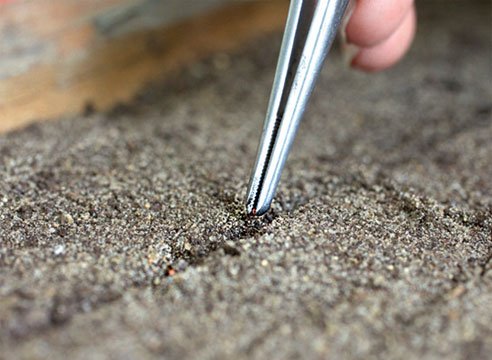

It is convenient to spread small basil seeds on the soil surface with tweezers
If the seeds were planted immediately in a spacious pot, then after the sprouts reach a five-centimeter height, soil is poured into the container, which will strengthen the young growth.
Picking
Sprouts that have sprouted in a small seed container will need a pick. It is carried out in the phase of 1–2 pairs of true leaves. The transplanting soil can be used the same as for sowing seeds. The seedlings are dug out carefully, without shaking off the soil from the roots, and immediately placed in small holes in the main container.
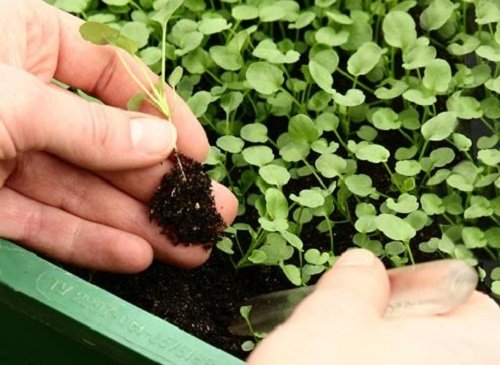

Seedlings are taken out of the common container using a plastic knife or other device, taking care not to damage the roots
An important condition! Since basil seedlings do not form adventitious roots on the stem, they are dived without deepening, that is, the planting depth should be the same as that of the seedlings.
After picking, the seedlings must be watered, if necessary, level the lopsided plants. Basil seedlings will need about a week to adapt to new conditions and start growing again.
Basil care
Plant pots should be in a well-lit area. From March to August, natural light is enough for him, and in late autumn and winter, growing basil will need additional lighting. In order for all the leaves to receive a sufficient amount of light, it is recommended to periodically rotate them on the windowsill. Potted soil should be kept moderately moist. Basil can be watered and sprayed daily in summer; in winter, watering is carried out twice a week. More frequent watering can lead to waterlogging of the soil and root rot.
Watering is carried out with water at room temperature, and after the procedure, the soil must be loosened shallowly to ensure the flow of oxygen required by the roots of the plant.


In order for the basil to grow, bush and branch, on your windowsill the air temperature should be at least 20 ° C (or even better, 25 ° C), and the sun should shine for at least 3-4 hours a day.
The air temperature in the room where the aromatic seasoning grows should be quite high - not lower than +20 degrees. Drafts negatively affect the plant. If strong blowing is felt on the windowsill, then the plant should be protected by wrapping the pots in a transparent plastic wrap. For homemade basil to delight you with its aroma and herbs for a long time, it must be fertilized.Analyzing the experience of indoor plant cultivation, you can advise organic fertilizing with vermicompost or Agrolife (according to the instructions). The number of dressings should not exceed 2 per month.


Organic fertilizers contribute to the saturation of crops with nutrients, which are presented in a balanced ratio
If you decide to use mineral fertilizers, then pay attention to the fact that you should opt for specialized mixtures for basil, and do not use formulations intended for other crops.
Video: harvest on the windowsill - we grow basil from seeds
Freezing whole leaves
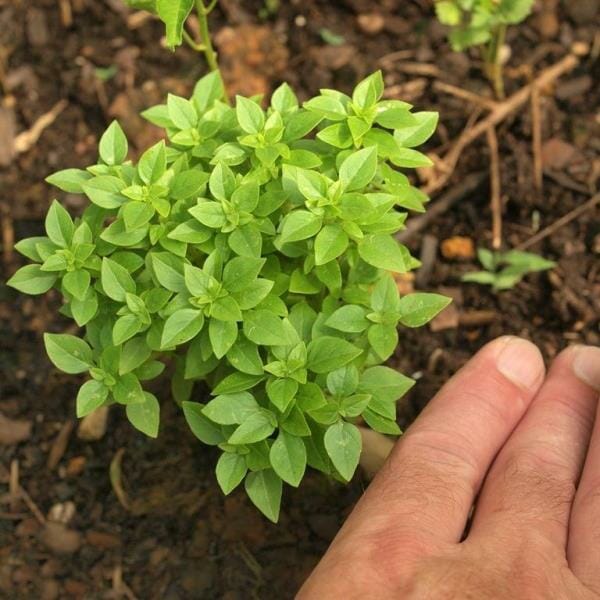

Basil plant care
You can prepare basil leaves for the winter by freezing them. To do this, they are washed, immersed in boiling water for a few seconds, then in cold water. After such contrasting procedures, the leaves are laid out on a towel. Once they are dry, they need to be arranged in bags and sent to storage in the freezer.
How and when to dive basil seedlings
Basil seedlings tolerate picking well, so you don't have to worry about the well-being of the plants. The optimal timing of the procedure must be determined by the plants themselves - seedlings should have 2 true leaves.
The soil for the procedure can be used the same as for planting. But you can mix 1 tbsp. l. mineral fertilizer or 2 tbsp. l. wood ash per five liters of potting soil.
You need to correctly dive basil seedlings according to the following scheme:
- water the plants a couple of hours before the procedure;
- fill containers with soil, slightly compact;
- make a hole in the middle with your finger;
- carefully pick up the seedling and transfer it along with a clod of earth into the recess;
- cover the hole with earth and carefully compact the soil around;
- water.
Important! Plants must not be buried when diving, they must remain at the same level as they grew before!
Leaving after a pick:
- A couple of weeks after the procedure, when the plants adapt and take root, you can feed it with a mineral complex fertilizer, including nitrogen, potassium and phosphorus in equal proportions. Before planting in open ground, you still need to feed it once every 14 days.
- After the seedling has 5-6 true leaves, it is recommended to pinch, which will slow down growth and help avoid overgrowth of seedlings, stimulate the growth of lateral shoots.
- 2 weeks before planting in the ground, you need to start hardening the seedlings. Plants can be taken out to fresh air only at a temperature of at least 12 degrees Celsius.
What varieties are suitable for marinades?
Basil varieties for marinades are distinguished by a rich fragrant aroma, do not lose taste and smell for a long time, and can be heat treated.
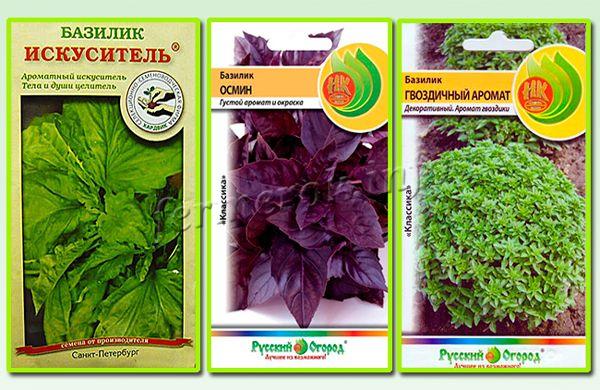

Basil varieties for pickles
- "Tempter" - a sort of basil bred specifically for marinades. Its leaves are green, large. The aroma is sharp, so small doses should be measured into the marinade, but during the marinating the smell does not disappear. Can be used fresh and dried.
- "Osmin" especially recommended for marinades, due to its rich, rich aroma and unobtrusive taste. Grows as a cultivated or ornamental plant. Its homeland is India, but not so long ago, this variety won the love of Americans and Europeans. This is a very thermophilic plant, therefore it is grown either in southern countries, or in pots on a windowsill on the sunny side.
The varieties "Clove aroma", "Ruby of Cairo", "Italian", "Eugenol", "Shirokolistny" described above can also be included here.
Feeding
It is imperative to feed the basil, because, as already mentioned, basil does not receive enough necessary elements from the soil on the windowsill, this will have to be corrected with frequent and regular baits. The plant will be grateful for the simple more familiar fertilizers made from compost and based on humates.Fertilize the soil once a month according to the concentration indicated on the package, and then your homemade basil will delight you with green, juicy leaves that can be safely added to a salad.
Photo
Further on the photo you can see how the spice grows:
Sowing seeds
The soil in the container is lightly patted down. Seeds are laid out on the surface of the soil.
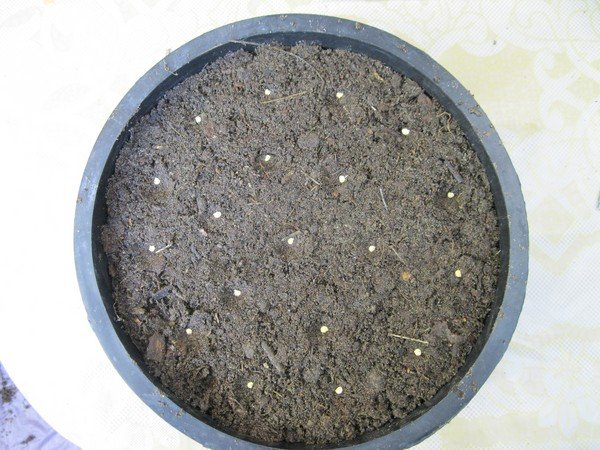

Five centimeters is the ideal distance between basil seeds. If the seeds are densely planted, the sprouts will have to be thinned out.
Dry seeds (not treated in a solution of potassium permanganate) can be planted by evenly shaking them off a white paper sheet.
After sowing, the soil surface is sprinkled with a layer of earth 10 mm thick. After that, the container is thoroughly watered. First, the soil is sprayed with water. Then watering is done from a small watering can, which does not create powerful water jets that can carry the seeds into the depths of the porous soil.
Specificity of the protective system of the spice
Basil is a fairly resistant culture to diseases and pests. The plant contains a large amount of essential oils, the smell of which repels insects. Harmful insects may become interested in the spice due to neighboring crops. Please note that the use of pesticide preparations on the plant, as in all green crops, is undesirable. The growing season is long. The crop is constantly cut for consumption. And the degree of pesticide content in the finished product is practically impossible to control. Therefore, preventive measures are of particular importance.
Contraindications to use
Due to its saturated chemical composition, basil has restrictions on its use:
- vascular thrombosis;
- epilepsy;
- violation of blood clotting;
- hypertension;
- recent heart attack;
- age up to 6 years;
- individual intolerance.
The use of basil during pregnancy is permissible, but with caution - a miscarriage is possible. When breastfeeding, the spice increases lactation, but the baby may develop allergies.
Preventive measures against plant diseases
- Follow the rules for changing crops and do not plant greens in one place all the time.
- Timely carry out the autumn-spring cleaning of the remnants of previous plants.
- It is recommended to dust the basil with wood ash once a week.
- Observe the technology of growing the plant.
- Kill weeds regularly and loosen the aisles so that a crust does not form, obstructing the flow of air.
- Ventilate greenhouses regularly.
- Break through crops in time.
- Diseased plants should be removed immediately and the soil should be disinfected.
The culture should be treated with decoctions and tinctures of biological "pesticides" - tansy, wormwood, calendula, garlic, hot pepper. The proximity of the culture with these natural insecticides to repel pests will help. Recommended for use on green tobacco dust, laundry soap. The benefits of dusting with wood ash have already been mentioned above.
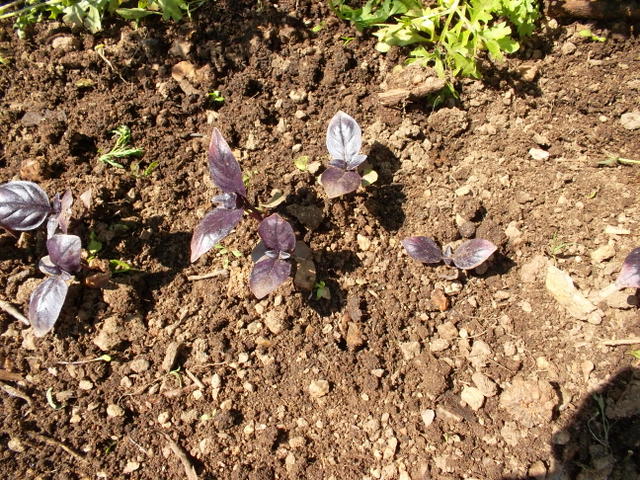

Cultural pests and how to deal with them
The greatest damage to the plant is caused by aphids and field bugs. These are small insects that feed on plant sap and lay a large number of larvae. You can detect an aphid or bedbug infestation by rolled, deformed leaves, by whitish spots. They treat pests with safe infusions, which were mentioned above, not only the plant itself, but also the soil around it. Processing is carried out two to three times with an interval of 10 days.
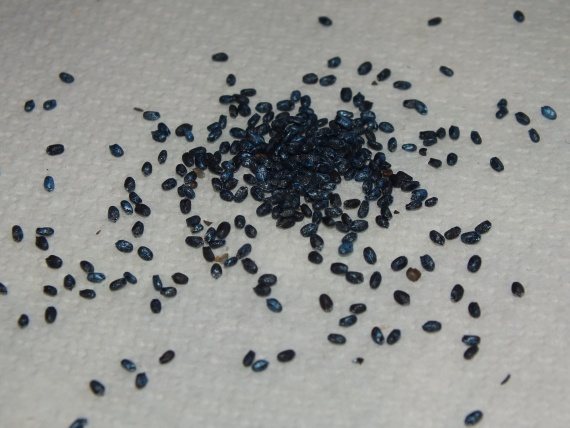

In case of severe damage to the crop, experts recommend processing the site with karbofos. Interestingly, some insects don't like the smell of basil. Sowing it near a place of evening rest - near a shop, a gazebo, you will get rid of mosquitoes and flies. A beautiful basil bush can be a decorative element in your site design.Basil will delight you with medicinal properties - bactericidal, antipyretic, anti-inflammatory, diuretic. Used in medicine and basil essential oil.
Interesting Facts
Many stories, legends, legends are associated with the seasoning.
- The ancient Egyptians used seasoning for mummification and made wreaths out of it. Because of this, basil has long been considered a symbol of death and was not used for food.
- There is a legend according to which Salome hid the severed head of John the Baptist in a pot of basil.
- The ancient Romans and Greeks sowed the seasoning with wild shouts and curses. It was believed that this was the only way the seeds would sprout.
- In the Middle Ages, people believed that a basil leaf, forgotten under an inverted cup, would turn into a scorpion. Some believed that even inhaling the scent of the seasoning would cause the scorpion to wake up in the head.
- But still more often basil was considered a symbol of love. In Italy, it was even customary to put a pot with him on the windowsill, as a conditional signal for a lover.
- And Indians believe in the divine protection of the seasoning, its ability to cleanse a bad aura and strengthen the immune system. The plant is the second sacred after the lotus.
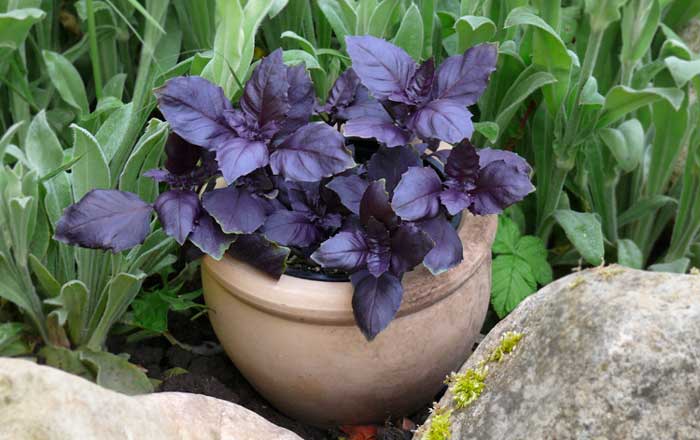

Did you like the article? Like it ♥, subscribe to our channel and you will be one of the first to know about new publications!
And if you have something to share - leave your comments! Your feedback is very important to us!
What kind of soil should be used for planting basil?
For this spicy herb, illuminated sunny places on the site are chosen. But the culture does not tolerate cold winds and drafts, so it is advisable to plant seedlings under the protection of large trees and shrubs, as well as near fences and various buildings. Basil thrives on loose, fertile and well-drained light soils. The best predecessors for it are cucumbers, tomatoes and legumes.
It is recommended to prepare the site for planting in the fall. When digging to a depth of at least 25-30 cm, the following fertilizers are applied per 1 m²:


- humus or rotted compost - 3.5-50 kg (depending on the nutrient composition of the soil);
- granular superphosphate - 20-25 g;
- potassium sulfate - 10-12 g.
Immediately before planting, the soil is abundantly watered with a solution of fertilizers (½ teaspoon of potassium chloride, urea and potassium sulfate per ½ bucket of water).
If the selected area is in the lowland, then it is better to make the beds high and fence them with boards or other material. Basil will not grow well on wet, waterlogged and airtight soils.
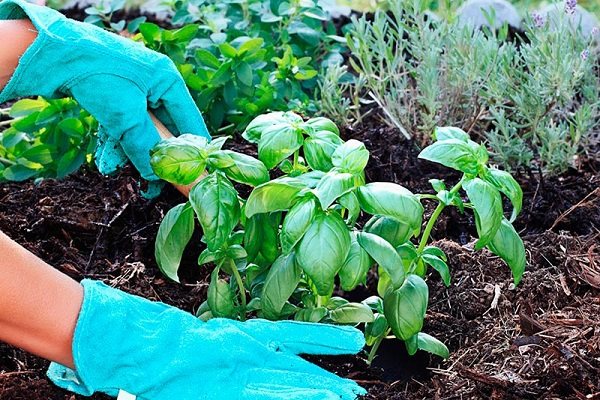

Cooking applications
Basil is widely used in cooking. It gives the dish a special taste and wonderful aroma. In addition, it enriches the body with vitamins and minerals, improves the functioning of the digestive system and soothes the nervous system. Basil is often added to salads. The spicy herb goes well with all vegetables.
Basil is a good addition to drinks and meals. Dried and fresh herbs are added during the preparation of meat, fish dishes, as well as seafood dishes.
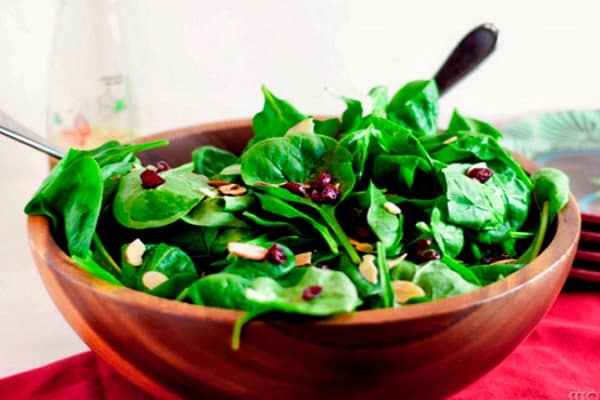

To make regular tea with basil, you will need to put black tea and a fresh purple herb leaf in a teapot. Pour boiling water over the mixture and leave to infuse for 10 minutes. Sugar is added to the finished tea.
Basil is often used in pickles. You will need basil branches and garlic cloves. Grass and garlic are placed in prepared sterilized jars. At this time, a marinade is prepared from a liter of water, to which salt, sugar and vinegar are added. Banks are poured with boiling marinade. The spicy herb prepared in this way can be added to hot dishes in the future.


Procurement and storage
The strong taste and tremendous health benefits are the main reasons why basil is so popular. In order to enjoy it as long as possible, you need to learn how to properly harvest and store a fragrant plant.
Freezing
For harvesting, you need to pinch off the leaves in the midst of basil growth, rinse, dry and put them in a bag for freezing, and then put them in the freezer. Thus, you will provide yourself with fresh greens for the whole winter. Of course, after defrosting, the leaves will lose their shape, but in vegetable salads or when cooking meat dishes, they will invariably give off their spicy, enchanting aroma.
Drying
The preparation process is very simple. It is necessary to collect the leaves (you can also use the stems), chop them and spread them out on a clean surface. Drying should take place in a well-ventilated warm room without direct sunlight on the leaves. You can also make bunches of basil sprigs, tie them up and hang them in the kitchen. Thus, you will have not only a bunch of dry greenery, but also a beautiful decor.
For drying, it is preferable to use young plants, since their stems are not yet coarse. Purple basil varieties are ideal for drying, as they are very fragrant even after drying.


Basil: preparation for the winter
Basil preparations
Modern medicine is increasingly seeking to use natural ingredients in the composition of medicines. Basil is no exception. It is widely used in the production of well-known drugs for the treatment of sore throat, cough. The composition of medicines for throat diseases contains, as a rule, an extract of leaves, seeds and roots of basil, which gives the drug an expectorant, antipyretic and antiseptic effect. Popular drugs that contain basil include: "Travisil", "Doctor Mom", "Suprima-broncho" and many others.


Basil: essential oil
Varieties by plant height
According to the height of the growth of the stem of the bush, they distinguish undersized, medium-sized and high varieties of basil. This feature becomes decisive when choosing a variety for growing. If there is not enough space, then you can choose a stunted variety.
Low-growing varieties stretch no more than 30 cm in height: Basilisk, Gnome, Gourmet, Stella, Malachite, Velvet. They can be grown at home, on a windowsill, all year round.
The average height of the variety of basil reaches 58 cm in height: Ararat, Gentle Early, Delight, Greek, Karakum, Smuglyanka.


Tall varieties of spicy herbs reach 82 cm in height: Pearl of the Moscow Region, Ruby of Cairo, Fantazer, Crimean violet.
General care rules
Correct care allows you to see the seedlings faster, carry out a pick, and get a good result. In about a week and a half, the first leaves will be visible.
But watering and fertilizing do not depend on this. Providing the right amount of water and trace elements, the gardener helps the basil to develop fully.
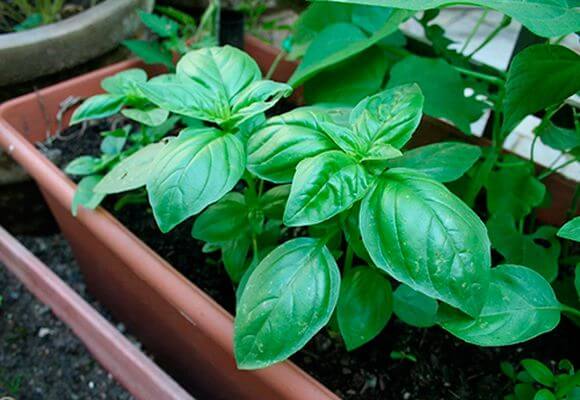

Watering
The crucial moment is watering the basil. The growth rate, the state of the root system and the humidity of the air depend on it. Therefore, the procedure is treated with increased care:
- Moisturize with drip. A 20 cc syringe is used.
- Irrigation liquid: room temperature withstand water for manipulation for 2-3 days.
- You can use the spray bottle before the young seedlings appear, and then to irrigate the adult basil.
Description
Description of the plant:
- Has a superficial, branching root system;
- The stem is tetrahedral, straight, branched, leafy, with villi. Height ranges from 50 to 70 cm;
- Sparsely toothed leaves with villi, oblong-ovoid. They are located on short petioles;
- The axillary flowers are pale pink, white, or purple in irregular whorls;
- The fruits are nuts, which are separated from each other after ripening.
How to care
The soil for good growth of basil should not only be rich in minerals, but also well moistened. At the same time, stagnant water can lead to the formation of black rot on the stems and leaves, so drainage is imperative.
About every two weeks, the plants are fed with complex fertilizer. It can be prepared independently using phosphorus, potash and nitrogen fertilizers in a ratio of 5: 3: 2 parts.
The landing frequency is self-regulated. Usually, for a comfortable growth, it is necessary to leave about 25 centimeters between the plants and at least 30 cm between the rows.
The video shows how to care for a plant:
The first time after transplanting, basil develops very slowly, so it is very important to provide it with regular weeding and eliminate weeds that can drown out the growth. At this stage, abundant watering is required (up to one liter of water for each plant).
After the plant goes into active growth, watering is reduced. The soil should not be too dry, but waterlogging will also create a threat of fungus on the stem.
To collect planting material for the next year, it is advisable to choose one plant, cut off numerous inflorescences from it, leaving several of the strongest. After the seeds are ripe, they are dried and stored until next spring.
Basil is used as a seasoning for salads, added to soups and other dishes, and is also harvested for future use in a dried form.
Why does purple basil turn green: reasons, what to do?
Summer residents are often worried about the question: why does purple basil turn green? Such a case is by no means uncommon. Many people think that the seeds were of poor quality. But it happens that purple entrances appear first, and then turn green.
This happens when there is insufficient sunlight. Basil should be under the sun 6-8 hours a day. If it is cloudy outside or basil grows on the windowsill in the shaded side, the leaves and tops of the plant begin to turn green.
You should not get rid of such a plant, everything is in order with it. It is enough to take out the basil to a sunny place, and the leaves will again take on a purple hue. If it is not possible to provide sunlight, it is recommended to install artificial lighting lamps in greenhouses and on window sills.
If basil is growing in the garden and has begun to turn green, wait for sunny days. You will see your basil bushes begin to change color.


Basil turns green
Picking sprouts
Picking is the process of transplanting sprouts from a common container into small containers. This must be done to ensure that the plants have enough space to form a strong root system.
The pick is carried out after the appearance of two cotyledons and two true leaves.
Peat pots or plastic cups are suitable for seating. Holes are made at the bottom of plastic containers to drain excess water.
The soil is poured into the container of the same composition as in the general container. It is recommended to add a third of a glass of wood ash and a tablespoon of complex nitrogen fertilizer to 5 kg of soil. The dive process is carried out in the following order:
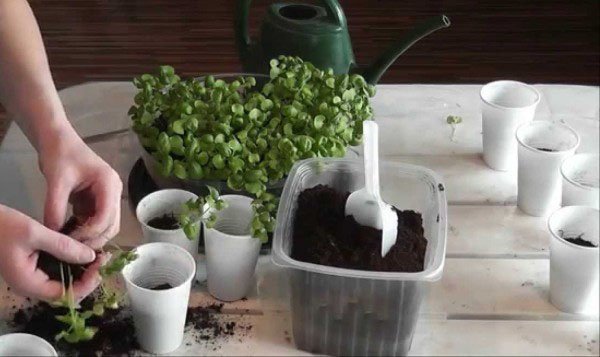

The cups are filled with earth and slightly compacted.- In the center, pits are made with a depth of 4-5 cm.
- The plant in a common container is dripped with the opposite end of a spoon or with a flat stick, the sprout is taken out along with a lump of earth. This is done carefully so as not to damage the roots.
- The sprout with an earthen lump is transferred into a glass, sprinkled with earth and slightly compacted.
- When planting, do not cover the stem with earth. The seedling will hurt, its growth will slow down.
- The soil in the cups is carefully watered.
The seedlings will adapt and will grow in a few days. After two weeks, they begin to harden. To do this, the containers are taken out daily to a room with a temperature of 5-10 degrees, first for 5-7 minutes. Gradually, the hardening time increases to 2 or more hours. You can harden basil on the veranda, in a ventilated room (but not in a draft).
When the soil warms up to plus 15 degrees, the plants are transplanted into a garden bed. If the seedlings are overgrown, and the transplant is delayed, the tops of the shoots can be pinched.This is done when 6-8 leaves appear.
What varieties can be used for baked goods and desserts?
Pastries, desserts and drinks are the main area for consuming basil varieties with caramel, cinnamon and vanilla aromas.
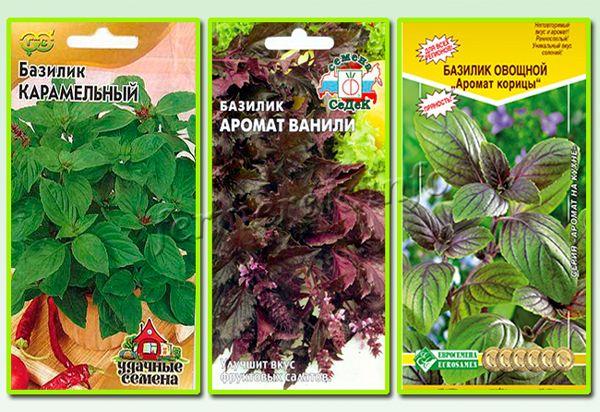

Varieties for baked goods and desserts
- "Caramel" - early look with a delicate fruity-caramel scent. Used simply as a seasoning to add a fruity caramel flavor to the dish. It grows not as a tall bush, it is grown mainly in apartments.
- "Vanilla aroma" - a tall variety with juicy, purple leaves when fully ripe. Vanilla flavor and aroma. Can be grown indoors, in greenhouses or outdoors. It is usually used as an additive in confectionery.
- "Scent of cinnamon" grows up to 40 cm, leaves are green. Up to 400 g of leaves are collected from the plant. The aroma and taste are cinnamon. Used for baking, desserts, marinades.
Also for baking, you can use the varieties of basil "Cinnamon", "Pet", "Malachite".
Benefit and harm
Basil essential oil contains:
- Vitamins: C, B2;
- Provitamin A;
- Carotene;
- Sugar;
- Phytoncides;
- Rutin;
- Camphor;
- Methylhavenol;
- Cineol;
- Ocimene;
- Linalool;
- Saponin;
- Tannins.
Beneficial features:
- Has antipyretic, bactericidal, tonic and tonic effect;
- Increases the immune functions of the body;
- It is indicated for inflammatory processes in the oral cavity;
- Effective for viral, bacterial and fungal infections, respiratory and pulmonary diseases;
- Promotes memory improvement, strengthening of nervous tissue;
- Relieves flatulence;
- Stimulates brain activity.
ATTENTION: Due to the insignificant content of mercury in basil, it is not recommended to use it in large quantities even for perfectly healthy people.
The use of basil is contraindicated:
- With diseases of the cardiovascular system (hypertension and hypotension), in particular after myocardial infarction;
- With vein thrombosis of the lower extremities, thrombophlebitis, vegetative-vascular dystonia;
- During pregnancy (in large quantities).
Watering your home basil
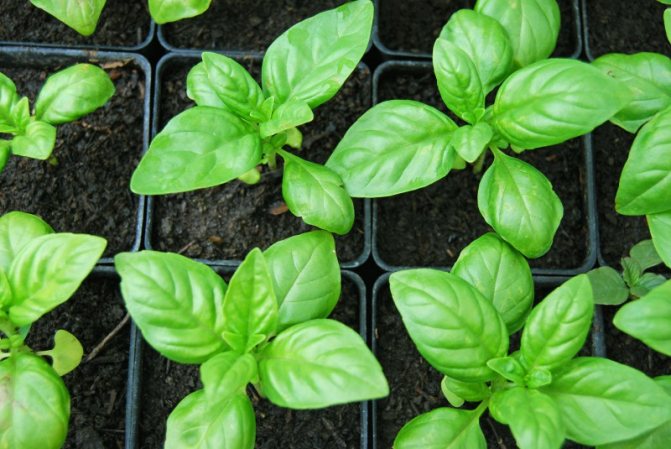

As already mentioned, basil loves moisture, and therefore the soil in the pot should always be slightly damp. The plant will have to be watered frequently, at least daily. Do not forget to water the plant, because often the basil grown at home is lacking some elements, and they need to be reimbursed. You will understand this when, without watering it once, the leaves of the plants will hang and fade.
But also avoid overflow, homemade basil is as susceptible to disease as usual.
Loosen the soil every three days, but do it carefully.
The main diseases of the plant and the fight against them
Among the main diseases of green crops, a special place is occupied by fusarium, black leg, gray rot. These are fungal diseases that develop with temperature changes, waterlogging, damage to the roots, on poor soils, in violation of the rules of crop rotation. Blackleg. Especially harmful to young seedlings, seedlings. The root collar of the sprouts is affected. It turns black, rots, seedlings die. Fusarium wilting (fusarium). The stem is affected, becomes brown, becomes thinner. In adult plants, the top dries up, the spice gradually fades.
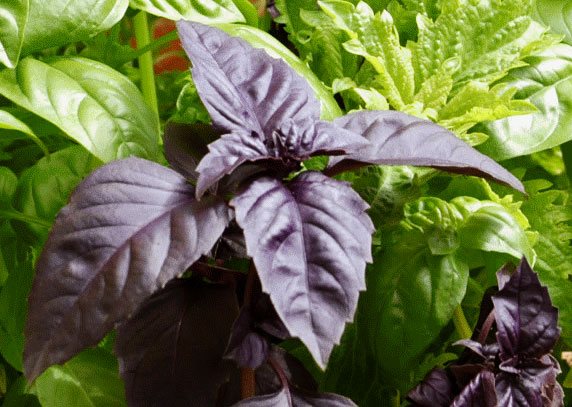

Gray rot. The disease can be determined by the affected lower leaves. Light brown dry patches will appear on them. Over time, they will be covered with grayish down. The fungus develops on plant debris, penetrates the plant from the soil. Recommended control measures:
- Spray diseased plants with infusion of onion husks. Pour 4 parts of the husk with 1 part of boiling water, leave for 24 hours, drain.
- Scald with boiling water 1.5 tbsp. wood ash, diluted in water (the proportion is indicated in a bucket of water), add 1 tbsp. spoon of liquid laundry soap. With this tool, experts recommend spraying the plant against aphids.
- Spraying with a 1% solution of copper sulfate will help.
As a last resort, when diseases or pests have affected 50% of the crop, it is necessary to spray the planting with fungicides (for example, foundazol, phytosporin), which can be bought in a specialized store.
Beneficial features
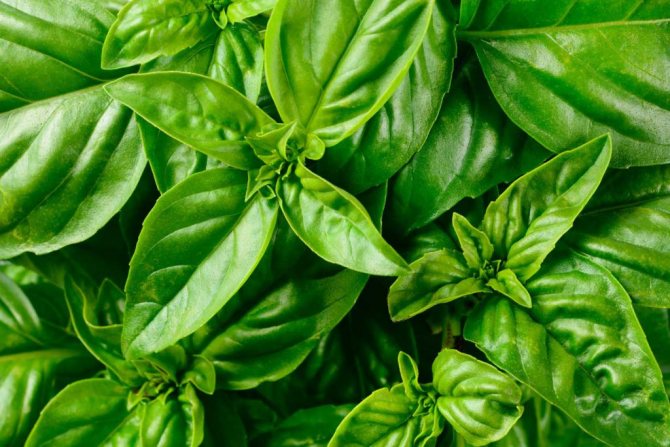

Let's continue to praise this wonderful green, it has a long list of beneficial qualities. It strengthens the immune system, is useful in cancer and HIV. As well as:
- has antiviral and antifungal properties;
- improves asthma;
- it has wonderful properties as an antipyretic agent;
- useful for flatulence;
- helps in the fight against insomnia;
- is a diuretic;
- actively reduces cholesterol;
- reduces toothache and pain during menstruation, and a decoction from it helps to get rid of bad breath.
Which ones are suitable for the middle band?
Good choices would be:
- "Clove".
- "Clove aroma".
- "Basil eugenol".
- "Greek".
- "Darkie".
- "Stella".
- "The Sultan's Dreams".
- "Dreamer".
- "The sorcerer".
- "Charm".
This pretty plant with a unique taste and rich aroma is used not only in Greek, Russian, Italian and other cuisines of the world. Valuable qualities of basil are also used in medicine., grown for the joy of the eyes and heart in home pots and summer cottages, used as a disinfectant.
Capacity and drainage
The capacity and method of planting is chosen by the gardener. You can plant seeds in one elongated container, but then a pick is required.
You can plant seeds in a snail. A dive process is also required. For 45% of gardeners, planting basil seeds individually is the easiest and most convenient way.
For this, both special peat pots and improvised means are suitable: glasses, cut bottles, kefir boxes, baby food jars.
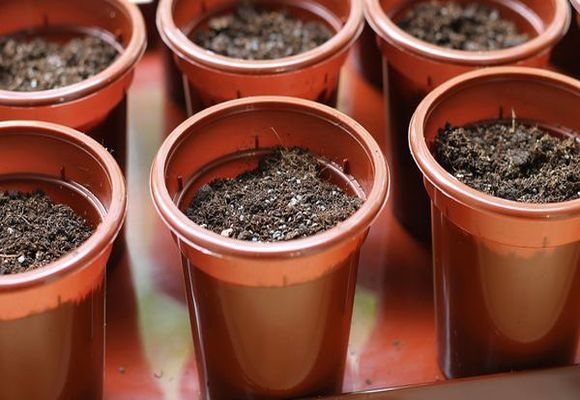

The main condition is a volume of at least 0.2 liters. Maximum - 5 liters. Seed material is planted with toothpicks.
Drainage is required. Expanded clay, broken brick, perlite or small stones are used. Basil does not like an abundance of moisture. Drainage flooring helps eliminate excess water. The container is filled with a drainage of 1 cm in the bottom of the container.
Varieties
The genus basil has about seven dozen species. The most common and well-known are the following:
Green curly basil. It is famous for its strong, sweet aroma. Gives a high yield. This view is preferred by most Englishmen. The bushes can stretch up to 50 cm in height. The edges of the leaves are wavy. The color of the leaf plates is predominantly light green. But there may be varieties with purple leaves.


Basil of Genoa. The most popular variety. This annual is characterized by large, oval, slightly convex, glossy dark green leaves, tapering at the ends, white flowers, intense aroma. The height of the entire plant can be up to 60 cm. In nature, it can be found in Italy.
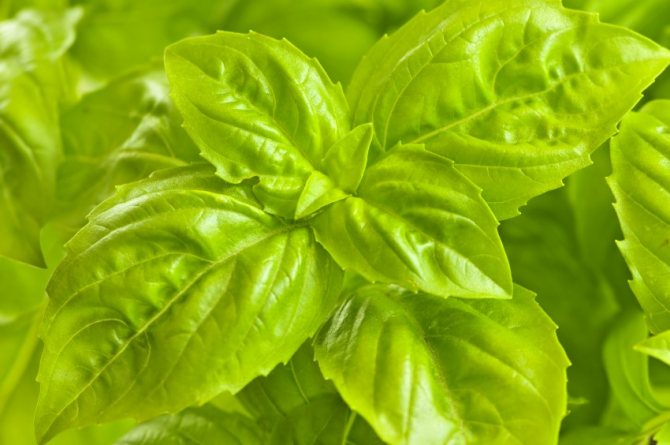

Basil of provencal. His homeland is the French south. Distinctive features - small toothed leaves, narrow with a smooth surface, a strong pleasant smell, low bushes. This is an annual.
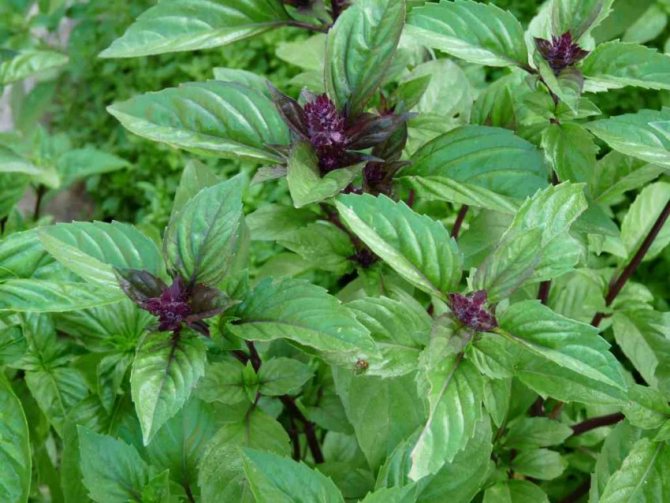

Recipes
Delicious pork goulash can be prepared according to the following recipe:
- Pork meat - 1 kg.
- Basil - 6-8 leaves.
- Garlic - 2-3 cloves.
- Onion - 1 head.
- Paprika and rosemary - 0.5 tsp each.
- Olive oil - 1 tbsp the spoon.
- Tomato paste - 2 tbsp spoons.
- Pepper, salt to taste.
The meat is cut into small pieces and marinated in spices with olive oil. Fresh herbs are washed, dried and chopped finely with a knife. Stew the meat over medium heat, covered with garlic, onions and tomato paste for half an hour. Chopped basil is added at the end of cooking, after which the dish is stewed for another 15 minutes.
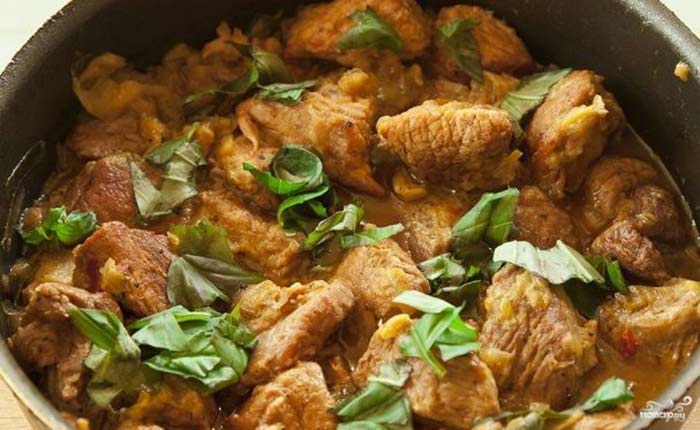

Strawberry jam with basil and mint very tasty and children like it. For 1 kg of strawberries, 5 basil leaves, 7 mint, 20 g of lemon zest and a pound of sugar are taken. The jam is prepared like this:
- Washed berries are covered with sugar for 20 minutes.
- After the juice appears, the cup is placed on the fire and brought to a boil.
- Then remove from heat and cool. This is repeated twice more.
- Mint, basil and lemon zest are dipped in the jam in a gauze bag in the last heating.
If you replace strawberries with raspberries in the recipe, you get not only tasty, but also a very useful product. In winter, it will help fight colds and strengthen the immune system.
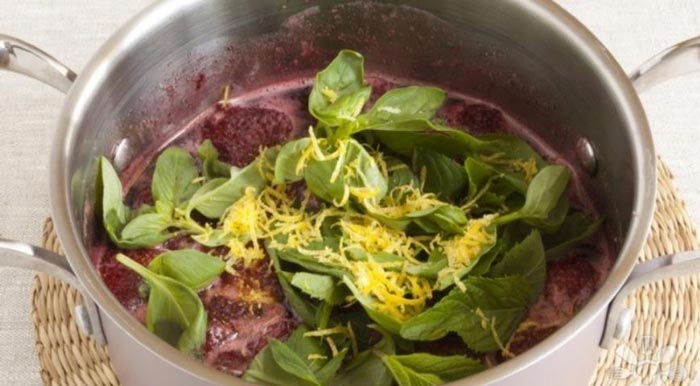

Basil and cucumbers go well with salting for the winter. Add horseradish root and 5-6 green basil leaves to a three-liter jar.
Pasta is prepared with seasoning according to the following recipe:
- King prawns - 0.2 kg.
- Spaghetti - 0.2 kg.
- Basil - 40 g.
- Garlic - 2 heads.
- Tomatoes - 3 pcs.
- Sugar, salt, black pepper, olive oil - to taste.
The shrimp are thawed at room temperature. Cut the tomatoes into slices, rub the garlic on a fine grater. Basil is chopped in strips.
The spaghetti is boiled, the shrimps are fried in a pan with butter for about 2 minutes. Then tomatoes with sugar and pepper are stewed in the same place for 5-8 minutes on low heat. Finally add basil, garlic, shrimp and spaghetti and mix everything together.


There are various options cocktails with basil... For example, a drink called Basil Strike would require:
- London Genie - 60 g.
- Lemon - 80 g.
- Sugar syrup - 20 g.
- Green basil - 5 g.
- Ice cubes - 300 g.
Basil and lemon are mixed in a shaker, sugar syrup, genie, ice are added there and whipped. When serving, the cocktail is garnished with fresh seasoning leaves.
